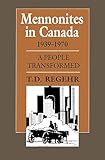Mennonites in Canada, 1939-1970 : A People Transformed / T.D. Regehr.
Material type: TextSeries: HeritagePublisher: Toronto : University of Toronto Press, [1996]Copyright date: ©1996Description: 1 online resource (600 p.)Content type:
TextSeries: HeritagePublisher: Toronto : University of Toronto Press, [1996]Copyright date: ©1996Description: 1 online resource (600 p.)Content type: - 9781442615038
- 9781442677227
- 289.7/71
- BX8116 .E68 1996eb
- online - DeGruyter
| Item type | Current library | Call number | URL | Status | Notes | Barcode | |
|---|---|---|---|---|---|---|---|
 eBook
eBook
|
Biblioteca "Angelicum" Pont. Univ. S.Tommaso d'Aquino Nuvola online | online - DeGruyter (Browse shelf(Opens below)) | Online access | Not for loan (Accesso limitato) | Accesso per gli utenti autorizzati / Access for authorized users | (dgr)9781442677227 |
Browsing Biblioteca "Angelicum" Pont. Univ. S.Tommaso d'Aquino shelves, Shelving location: Nuvola online Close shelf browser (Hides shelf browser)

|

|

|

|

|

|

|
||
| online - DeGruyter Medieval Rhetoric : A Select Bibliography / | online - DeGruyter Memoirs of a Very Civil Servant : Mackenzie King to Pierre Trudeau / | online - DeGruyter A Mennonite Family in Tsarist Russia and the Soviet Union, 1789-1923 / | online - DeGruyter Mennonites in Canada, 1939-1970 : A People Transformed / | online - DeGruyter Mennonites in the Global Village / | online - DeGruyter Mergers in Higher Education : Lessons from Theory and Experience / | online - DeGruyter Migration Italy : The Art of Talking Back in a Destination Culture / |
restricted access online access with authorization star
http://purl.org/coar/access_right/c_16ec
When war broke out in 1939 Canadian Mennonites were overwhelmingly a rural people. By 1970 they had largely completed one of the greatest `migrations' in their history - the transformation from a rural to an urban community. In this third and final volume of Mennonite history in Canada, T.D. Regehr shows how the Second World War challenged the pacifist views of Mennonites and created a population more aware of events, problems, and opportunities for Christian service and personal advancement in the world beyond their traditional rural communities. Regehr describes how the war also initiated the urbanization process and brought in its wake a new wave of Mennonite immigrants, with different traditions and values, from Europe.Regehr traces as well the less cataclysmic and more far-reaching influences of urbanization on Mennonite identity. He demonstrates how the specialization, rationalism, and individualism that typically accompany the shift from a rural to an urban society produced new vocations, including a large business and professional class; created new values that were often at odds with traditional ones; and profoundly affected community and church life. Regehr balances a detailed institutional analysis with numerous insights into the lives of ordinary people, stressing the role and problems of women in what has been essentially a patriarchal society. Though, as he shows, the Mennonites were `a people transformed,' they were not assimilated. They retained a separate identity and preserved the distinctiveness of their faith and culture.
Mode of access: Internet via World Wide Web.
In English.
Description based on online resource; title from PDF title page (publisher's Web site, viewed 01. Nov 2023)


